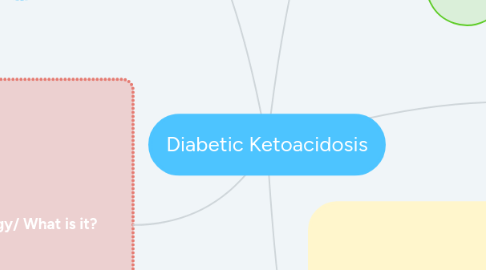Diabetic Ketoacidosis
by Jade Gilbert

1. Pharmacological Intervention
1.1. Describe the treatment for ketoacidosis. - administer IV sodium bicarbonate if severe acidosis (pH <7.0) - administer oxygen as per physicians order - Administer potassium IV to correct hypokalemia - Begin continuous regular insulin drip (0.1units/kg/hr as needed) - Begin fluid resuscitation with 0.9% NaCl solution
2. Etiology/ What is it?
2.1. Lack of insulin Reason: infection, non compliance
2.1.1. Most common causes are underlying infection, disruption of insulin treatment and new onset of diabetes.
2.1.2. Type 1 Diabetes - New Diagnosis
2.2. Absolute or relative insulin deficiency aggravated by ensuing hyperglycemia, dehydration and acidosis producing derangements in intermediary metobolism
2.3. A problem with insulin therapy. Missed insulin treatments or inadequate insulin therapy or a malfunctioning insulin pump can leave you with too little insulin in your system, triggering diabetic ketoacidosis.
3. Pathophysiology
3.1. Causes lipolysis: insulin deficiency causes body to metabolize triglycerides and amino acids instead of glucose
3.2. Elevated blood sugar, body uses fat for energy. Giving insulin metabolizes glucose and blood sugar breaks down and fat burning stops
3.3. Lab abnormalities may include hyponatremia Elevated serum creatinine Elevated plasma osmolality
3.4. Serum amylase and lipase often elevated
3.5. Diagnosis arterial ph less than 7.3
4. Health Teaching
4.1. Hgb (hemoglobin) RBCs low, she needs to eat properly. Ex fish, meat, seeds, nuts, leafy greens.
4.2. Alcohol consumption and exercise both lower blood sugar and can induce DKA
4.3. Ongoing education, not just done once, regarding prevention and complications surrounding diabetes
4.4. Proper educational teaching and to be provided in a style of delivery so she can ideally understand
4.5. Test urine for ketones If your not eating do not stop your insulin completely. Your body needs insulin even if you are not eating
4.6. If blood glucose is high, take extra insulin to control it
5. Complications
5.1. Myocardial infarction Hypokalemia
5.2. Infections Peripheral vascular disease Hypoglycemia Allergic reaction can happen
5.3. Hyperlipidemia Over weight High blood pressure


